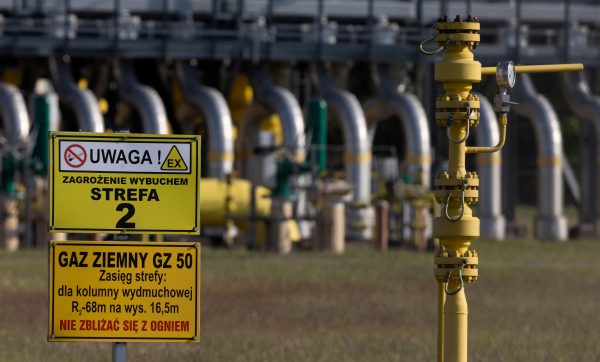For years Moldova has been one of Europe’s most vulnerable countries.
Lacking resources of its own, it has been importing all its natural gas from Russia and three quarters of electricity supplies from the Russian-backed and occupied Transnistrian breakaway republic.
The war in Ukraine, Europe’s crippling energy crisis, and the Kremlin’s pervasive threats against its pro-European Union (EU) government have prompted it to make historic changes to limit its energy dependence on Russia.
But the transformations that are now afoot are also fraught with economic and political risk.
Russia’s decision to reduce gas supplies at the start of October 2021 and the prospect of a complete curtailment ahead of winter has jolted Moldova into action over the past year.
A small team of local and international experts at the state electricity and gas wholesaler Energocom was tasked to scour the region for alternative supplies and routes.
This has paid off.
Within a few months, the country secured €300m ($315m) in funding from the European Bank for Reconstruction and Development (EBRD) to buy and store gas in neighboring Ukraine.
On electricity, the most significant achievement has been the synchronization of its power transmission lines with Europe’s.
Just hours before the Russian invasion on 24 February, Ukraine and Moldova jointly switched off their electricity grid from the legacy Soviet infrastructure and coupled up with the continental European system, a year earlier than expected.
The start of commercial electricity flows with neighboring EU countries later in the summer allowed both the export of more electricity regionally, and the raising of much-needed funds.
But the real benefits only became evident in October when Gazprom once again reduced gas deliveries and threatened to stop them altogether amid claims Moldova was not paying for supplies.
By then, Moldova had already accumulated enough gas in Ukrainian facilities to cover six weeks of peak winter demand and, having no storage of its own, had also injected some volumes into the grid of neighboring Romania.
When electricity exports from Ukraine and Transnistria also stopped amid heavy Russian bombardment of Ukraine’s infrastructure and limited gas supplies, Moldova turned to Romania for emergency imports to avoid blackouts.
Historically, Moldova has depended on 70% of its electricity consumption on power generated at a gas-fired power plant in Transnistria.
The remaining 20% was sourced from Ukraine and only 10% came from Moldovan production.
Moldova and Transnistria have been locked in an awkward interdependence harking back to Soviet times.
Moldova imports three billion cubic meters of Russian gas annually, but two-thirds of this goes to the unrecognized breakaway province, where a portion is used to generate electricity and sold back cheaply to Moldova.
The Romanian imports have been a burden on Moldova’s limited budget, being five to six times more expensive than deliveries from Transnistria, currently priced at $73 per megawatt hour (€69.45/MWh.)
Nonetheless, their symbolic significance was not lost on those who have been hoping to see Romania and mostly Romanian-speaking Moldova — once a unified state — working more closely together after almost a century of separate political existences.
It is now clear that Moldova achieved more in diversifying its energy supplies and routes in 2022 than throughout the last three decades since its independence.
As a contracting party of the Energy Community, a European institution promoting free market principles, it has been reforming its energy sector and aligning with most European regulations.
By working with Ukraine and Romania to secure and store gas, it has also succeeded in blunting Russia’s ability to blackmail it politically.
A new short-term deal announced at the start of December and bringing gas in reverse from Bulgaria into Moldova via Romania and Ukraine is also likely to pay dividends, even if the gas sourced in the Balkans were of Russian origin.
The new route not only helps Moldova to raise more transit revenue but also creates an opportunity to partially disentangle itself from joint gas supply arrangements with Transnistria.
Thanks to this deal, Moldova can retain all the gas imported from the south for its needs while Transnistria can use the volumes entering from the north to resume cheap electricity supplies to Moldova.
The deal is not without political and economic challenges, however.
If European electricity prices were to fall sufficiently for Moldova to reduce or halt Transnistrian imports, the province could be paralyzed economically since electricity sales provide most of its revenue. That would likely force Russia to assist its statelet, and would no doubt generate more threats to Moldova’s government.
For now, the measures that Moldova has been putting in place should give it a degree of security, even if the price paid to free itself from Russia’s grip has been high.
End-consumer bills have soared tenfold compared to last year, and the risk of political and social unrest should not be discounted.
Moldova is in a much less precarious supply situation than a year ago, but the months ahead will tell if it can stay the course.
Dr. Aura Sabadus is a senior energy journalist who writes about Eastern Europe, Turkey, and Ukraine for Independent Commodity Intelligence Services (ICIS), a London-based global energy and petrochemicals news and market data provider.
Her views are her own.
Europe’s Edge is CEPA’s online journal covering critical topics on the foreign policy docket across Europe and North America. All opinions are those of the author and do not necessarily represent the position or views of the institutions they represent or the Center for European Policy Analysis.





